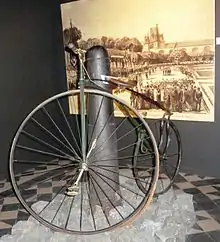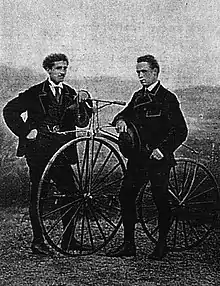Eugène Meyer (inventor)
Eugène Meyer was a French mechanic credited with making important contributions to the development of the bicycle. He received a French patent for wire wheels in 1868 and is now believed to be the person primarily responsible for making the penny-farthing feasible and widely known.[1]

Eugène Meyer bicycle circa 1870 on display at the Wielermuseum in Roeselare, Belgium

James Moore, (right) winner of Paris–Rouen 1869 and Jean-Eugène-André Castera, (left) runner up, posing with a Meyer bicycle
Biography
Meyer was born in Alsace and lived in Paris. He raced his own bicycles in order to promote them and placed 10th in the 1869 Paris-Rouen race. James Moore rode a Meyer high wheeler at the Midland Counties Championship in Wolverhampton in August 1870, and thereby introduced the design to England.[2] Meyer died in Brunoy en Essonne at the age of 63.
References
- Tony Hadland and Hans-Erhard Lessing (2014). Bicycle Design, an Illustrated History. MIT Press. p. 92.
Eugene Meyer ... gets the credit for making the high-wheeler feasible and making it known.
- Herlihy, David V. (2004). Bicycle, The History. Yale University Press. p. 160. ISBN 0-300-10418-9.
This article is issued from Wikipedia. The text is licensed under Creative Commons - Attribution - Sharealike. Additional terms may apply for the media files.
